|
Nearly
every soaring enthusiast is familiar with Schweizer's model 1-26 glider,
having been around since before most of us were born. Incredibly, it was
the new kid on the block at the 1954 Soaring Nationals as reported in this
December 1954 edition of Air Trails. The
Schweizer 1-26 had just been introduced in January of the same year.
Another familiar name to aviation enthusiasts in general is Peter Bowers,
designer of the Fly Baby homebuilt monoplane and biplane. Who knew Bowers was a glider
guy as well? While names are being dropped, how about
Paul MacReady, the
Gossamer
Condor designer? This contest was a virtual Who's Who of yet-to-be hangarhold[sic]
names. See 15th
National Soaring Contest in the December 1948 Air Trails, the
20th National Soaring Contest in November
1953 Air Trails and the 21st National Soaring
Contest in the December 1954 Air Trails. Soaring Nationals
Blistering desert-like heat and adverse weather made this one of the hardest
meets for contestants. But it proved 0 triumph for home-builders whose ingenious
sailplanes took the first three places
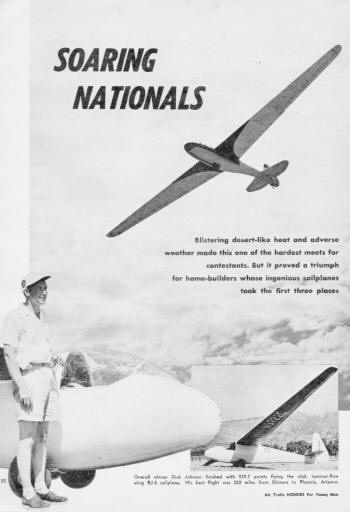
Overall winner Dick Johnson finished with 929.7 points flying the
slick, laminar-flow wing RJ-5 sailplane. His best flight was 320 miles
from Elsinore to Phoenix, Arizona.
The 21st American Soaring Championships held at Elsinore, Calif. marked
the first time that such a meet has taken place on the West Coast.-Statistically,
the 45 contestants flew 40 ships for 8,303 official miles. Dick Johnson
and his RJ-5 won the championship for an unprecedented fourth time, once
more than Paul McCready. The Fauvel AV -36 built by Fred Jukich and B. Hall
of San Francisco made its first appearance in this country. Gus Briegleb
soared an Aeronca Sedan with its prop tied down to demon-strate to the thousands
of spectators that you don't fall when the fan stops. These were some of
the highlights. There were two types of flying competition: task
days when everyone flew a course established by the contest committee, and
open days when pilots picked their own destination. Most days found good
lift over Elsinore Valley; on one occasion 11 ships were in the same thermal.
The jockeying for take-off time was very interesting, for the lift usually
started about 12:15. Those who were left with take-off times prior to this
usually landed soon, returning to the air about 2:30. Some found enough
lift barely to hold their own, and we can remember six ships directly over
the field on one day which must have been in "zero sink" to 50 ft. per minute
lift, for they floated over-head at an altitude of about 500 feet for more
than three-quarters of an hour before they managed to climb up and away.
There were three ships which demonstrated in advance their ability
to outstrip all others, and a fourth which unluckily, due to pilot illness,
did not accomplish much flying. The RJ-5 was undoubtedly in best trim. Ray
Parker's Tiny Mite was modified by adding wing and flat topping and refinished
slicker than glass. The third ship was the Kern-Maxey which had beautiful
sheet-metal work. The ship was of very high aspect, three-piece wing, V
tail, and had been test-hopped two days prior to the opening of the meet.
On its third flight it flew 283 miles to Mesquite, Nevada. The fourth
ship was Harry Perl's Penetrator. Harry himself was ill and so did no flying,
but later in the contest Doc Sawyer gave up on the Mitchell Nimbus until
more work could be done on it and flew the Penetrator. The wing on this
latest Perl design is very unique in that the leading edge back to the main
spar, which is the 30% chord line, is filled to the contour with Styrofoam,
then covered with plywood. Harry claims no rippling occurs under any conditions.
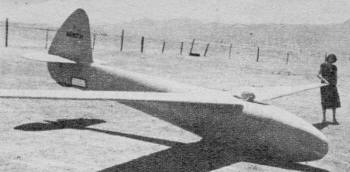
Second place went to Ray Parker of Twenty Nine Palms, Calif., who flew
one of the prettiest sailplanes at the contest, the "Tiny Mite. Parker
earned 773 points, won trophy for best modified ship.

One of the new and interesting sailplanes at the meet was the "Penetrator"
designed and built by Harry Perl who engineered the Nelson Hummingbird
powered glider. Due to sickness, Perl was unable to fly.

Another newcomer was the low-slung "Nimbus" built by Dan Mitchell, formerly
associated with Hawley Bowlus. Ship was flown by Dr. J. B. Sawyer. Very
thin wing with sharp leading edge. Mitchell at right.
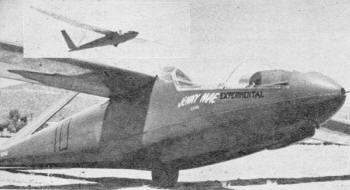
In third place was Lyle Maxey of Playa Del Rey, Calif., with his all-metal
Kern-Maxey. Dive brakes can be seen on fuselage under wings. Best flight
was 223 miles to Mesquite, Nev. Ship carried radio.

Old-timer Don Stevens took first place in Class III category with a
much modified Bowlus Baby Albatross equipped with tip plates, tip wheels
and streamlined pod which give supersonic look.
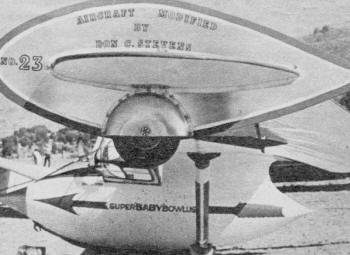
Stevens, a prewar soaring pilot, flew military gliders during it.
The new Schweizer 1-26 in the hands of Clarence See gave an excellent account
of itself and but for an unfortunate experience would have been much higher
in the standings. On one day when Banning and return was the task, Clarence
made it to Banning before the observer arrived, with 6500 feet of altitude,
only to circle and land where no marker was visible. Though he had an excellent
chance .to make it back, his was not one of the two ships that succeeded
- the RJ -5 and the Tiny Mite; Parker won over Johnson due to better elapsed
time. On this day Banning was the milk run; lots of rumors of a
big card game while pilots awaited ground crews. Other days it was Hemet,
20 miles distant, with more ships landing there than making it out.
In addition to winning his fourth championship, Dick Johnson took Class
I first place. Ray Parker captured best Goal and Return, best Distance and
Return and also the award for best Modification. Women's Champion was Betty
Loufek, Junior Cham-pion was 14-year-old Ross Briegleb. The Club Cham-pionship
was won. by Associated Glider Clubs' of Southern California from San Diego;
Two-place Champ, Bill Beuby; Class II, Harold Hutchinson, Class III, Don
Stevens. In design competition the best Intermediate Type Glider and Sweepstakes
went to Schweizer for their 1-26, the Best Design of High-Performance Sailplane
to Harry Perl, his Penetrator barely nosing out the Kern-Maxey.
Pete Bowers, long prominent in soaring in the Northwest, had the oldest
ship at the meet-a 1934 Wolf. With it he placed second in Class III and
point-wise halfway in the middle of the field of 36 pilots; a fine performance,
considering the age of his sailplane. Believing that its owner has earned
the right to make observations, we quote some of them about the contest
in general: "This was the first Nationals for most of our pilots,
and our group was considerably handicapped by lack of experience and knowhow
... The major deficiency was in crewing ... Since volunteer crews were hard
to find at Elsinore, the crew less were reluctant to head away from the
field for an unknown landing spot . . . "Altogether, some six tow
planes were in service, three Fairchild PT-23s, a Piper Clipper, a Meyers
with 160 Kinner, and a J-3 Cub. An oddity was the fact that Gus Briegleb's
Cinema was aero-towed to the meet from El Mirage, and Ross Briegleb, the
14-year-old who was flying it, had to pick his fields for landing away from
the airport so that his Dad could come after him with tow plane and retrieve
him by aero tow. "The ship simply could not be taken apart for trailering!
"Some of the ships that used take-off dollies had trouble in getting
off on eastbound take-offs due to deep sand at the west end of the field.
Some skipped the removable wheels altogether and towed off on their skids.
. . . "The contest weather was mediocre by anyone's standards. The
incomparable Dick Johnson got away for one 320-mile flight, but Banning,
32 miles from Elsinore, was the best that the majority of pilots could do.
"Only a mere handful of top performers like Ivans, Bikle, Ray Parker,
and Lyle Maxey were able to bypass Banning with consistency .... The big
problem was to break out of the valley through one of the passes. With good
cumulus clouds around, it would have been no problem, but a high-pressure
area sat over the coast for the entire time of the meet, and sea air blowing
in along with the Los Angeles smog kept the thermals small and at low altitude.
What ones there were were tough to handle, and every foot of altitude and
every mile of distance was earned the hard way .... " "Except for
the weather that left much to be desired, the meet can be called a huge
success, No one cracked up a ship and no one was hurt. A lot of people learned
many things about flying in a big contest .... "
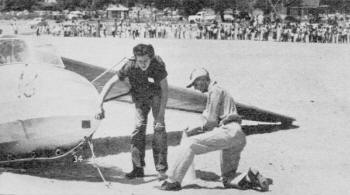
Junior Champion was Ross Briegleb, 14 (left), of El
Mirage, Calif., shown after landing 2 ft. from marker during spot landing
contest. Father Gus aero-towed him to meet, also retrieved him via air route.

Fouvel AV-36 Monobloc French flying wing sailplane,
made its first appearance in U.S. at the contest. This interesting
and controversial sailplane built from plans by F. Jukich and
B. Hall, San Francisco.
Posted December 31, 2012
|



